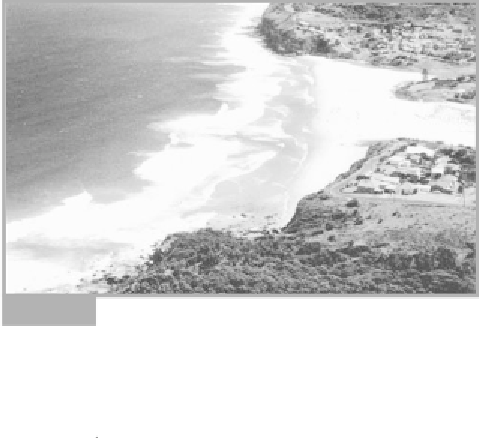Geoscience Reference
In-Depth Information
Natural factors are perhaps still the major causes of
beach erosion. Long-term changes have been best
documented on beach forelands along the Channel
and east coast of England at Dungeness, Orford Ness,
and Scolt Head Island. These forelands are tens of
kilometers wide and appear to have developed since
the Holocene rise in sea level, following the last glacia-
tion. However, some are slowly migrating along shore.
Material is eroded from the updrift ends and deposited
as a beach ridge on the downdrift end. In addition,
shorter term beach erosion has manifested itself in the
twentieth century, mainly because of the change in
global climate that has occurred since 1948. This
change has not been one of magnitude as much as one
of variation: the storms follow longer periods of quies-
cence, record rain and floods break severe droughts,
and the coldest winter on record is followed by the
warmest summer. Unfortunately, investigations of this
climate shift have focused on temperature change,
whereas the shift also involves dramatic changes in
coastal rainfall regimes, and changes in pressure cell
location leading to an upsurge in storminess.
While sea level rise enhances beach erosion by ele-
vating beach watertables, logically any factor affecting
watertables can also cause beach erosion. For instance,
a sandy backshore absorbing rainfall acts as a time-
delaying filter for subsequent discharge of this water to
the sea through the lower foreshore. The process can
raise the watertable substantially for periods up to two
months after heavy rainfalls. Many coastlines, espe-
cially those where seasonal orographic rainfall is pro-
nounced, can receive over 1000 mm of precipitation
within a month. Under these intense rainfalls, even
sand suspension on the shore face by groundwater
evulsion is possible. Rainfall may be better related to
beach change than sea level. This aspect can be shown
for Stanwell Park Beach (40 km south of Sydney, Aus-
tralia): a compartmentalized, exposed, ocean beach
with no permanent longshore leakage of sediment. The
beach over time has oscillated between extreme
erosion and accretion, but with no long-term trend in
either state (Figures 2.11 and 8.13). Figure 8.14 plots
the relationship defined between average deviations
from the mean high tide position and (a) monthly sea
level and (b) monthly rainfall for this beach between
1895 and 1980. Rainfall explains more of the change in
shoreline position over time than does sea level
(8.7 per cent versus 6.6 per cent). Despite all of the
above factors, the most logical cause of beach erosion
Fig. 8.13
Difference in beach volume, Stanwell Park, Australia.
Above, the beach after sustained accretion in February 1982.
Below, the same beach when eroded severely by a storm in
August 1986 (photograph courtesy of Dr Ann Young,
Department of Geography, University of Wollongong).
is increased storminess. Figure 8.14(c) plots, between
1943 and 1980, the relationship between the high tide
position and accumulated heights of storm waves for
the previous year on Stanwell Park Beach. Each 1 m
increase in storm wave height led to 0.47 m of beach
retreat - a value equivalent to the effect generated by
a 1 cm rise in mean sea level. The relationship is twice
as strong as that produced by rainfall and/or a rise in
sea level. In fact, storms are often accompanied by
higher sea levels and heavy rainfall. Storms concurrent
with these phenomena can explain 40 per cent of
the variation in shoreline position at Stanwell Park
Beach. In contrast, periods without storms favor
beach accretion.
This effect is also recognizable elsewhere. Evidence
from the barrier island coastline of eastern North
America, between New Jersey and South Carolina, not
only indicates large spatial variation in long-term rates
of erosion of barrier islands induced by storms, but also
shows that particularly large storms tend to erode or
overwash the shoreline more in the places having the





